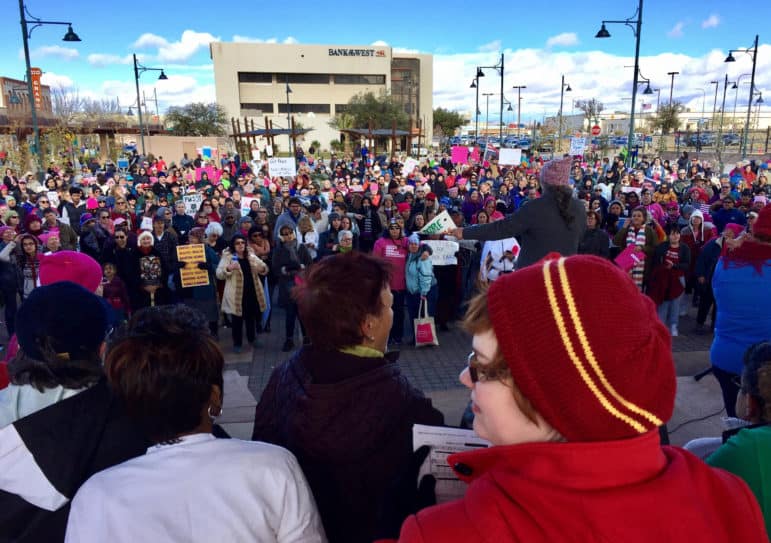
Heath Haussamen / NMPolitics.net
At the Women’s March in downtown Las Cruces on Jan. 21, 2017.
Albuquerque’s Melanie Stansbury decided this was the year to run for office. She filed as a candidate for state representative in Albuquerque, in House District 28 in the Northeast Heights. Republicans have held the seat for over a decade but the Democrat is running an energetic campaign and raising thousands of dollars in donations.
Stansbury followed the lead of her sister, a county judge who almost a decade ago went through the Emerge New Mexico program, which trains Democratic woman to run for office.
Stansbury joked that she and her sister are the only “Emerge sisters to actually be real sisters in New Mexico.”
The two familial sisters aren’t alone. A growing number of women are running for office, nationwide and in New Mexico.
Two of the state’s three congressional races will likely send women to Washington D.C. It will be the first time in state history two women represent New Mexico districts in Congress at the same time.
And if Democratic gubernatorial nominee Michelle Lujan Grisham prevails over her Republican opponent, Steve Pearce, women will have stood at the top of state government for three consecutive terms, after Republican Susana Martinez.
Further down ballot, women prevailed in six out of eight state House primaries.
Stansbury’s road to electoral politics began in the 2017 Emerge New Mexico program.
She wasn’t the only one. She noted that EMILY’s List, a group that helps candidates who support abortion rights, heard from 900 women who wanted to run for office in 2016. Those numbers jumped exponentially after the 2016 election: 40,000 women wanted to learn about running for office in 2018.
Stansbury said the 2016 election “really shook people awake.”
“I think that the things that have unfolded with the #MeToo movement and everything that’s happened over the last couple of years has just made people so much more conscious of how critical it is that they get involved, not only in politics, but getting involved in their communities, stepping up to do volunteer work,” she said.
Stansbury has already been involved in public service. She worked in the White House Office of Management and Budget during the Barack Obama administration, before moving to the Senate Energy Committee, where she notes she worked for ranking member Maria Cantwell, a Democrat from Washington. In that position, she worked closely with Sen. Lisa Murkowski, the committee chair and senator from Alaska.
“I think it really inspired me to realize that you can be a deeply thoughtful woman in leadership and bring something to the table,” she said.
NM Political Report reached out the Republican Party of New Mexico for more than a week seeking interviews about the party’s efforts to elect more women, but did not receive a response.
Not the first ‘Year of the Woman’
“I don’t think we’ve seen this kind of surge since the 1992 race, [which] was also called the ‘year of the woman,’” Lonna Atkeson told NM Political Report.
Atkeson is a political science professor at the University of New Mexico who studies elections and gender politics.
Many women are running in response to the election of Donald Trump, who at least 19 women have accused of sexual misconduct, and the #MeToo movement that came after the accusations against movie producer Harvey Weinstein.
But she said also institutional changes have helped.
“There have been workshops across the country helping women to run,” Atkeson said. “And there have been large investors that have put money towards bringing female candidates to teach them how to run for office.”
She said these efforts grow the candidate pool by teaching potential candidates, like Stansbury, what to expect when running for office.
As Atkeson noted, this isn’t the first time pundits and journalists have referred to a year as the “Year of the Woman” in politics. Some thought 1984 would be that year, when Democratic presidential nominee Walter Mondale chose New York Congresswoman Geraldine Ferraro as his running mate. That ticket lost in a historic landslide to Ronald Reagan’s re-election campaign.
And it wouldn’t be until 2008 that a woman was on a presidential ticket, when John McCain chose Sarah Palin to fill out the Republican ballot.
But in 1992, 19 women won U.S. House seats and four won U.S. Senate seats.
Dianne Feinstein and Patty Murray, both Democrats, are still serving in the U.S. Senate.
After elections in 2012, another year dubbed “Year of the Woman” by some, women held a record 20 seats in the U.S. Senate. And political experts told CNN that women were a key part of Barack Obama’s easy re-election campaign.
New Mexico has seen recent success in the past few decades, especially recent years, with women winning elected office. Martinez, the current Republican governor, easily won two terms. Former U.S. Rep. Heather Wilson served five full terms before leaving the seat for an unsuccessful run for U.S. Senate. And current Democratic gubernatorial nominee Michelle Lujan Grisham is in her third term as U.S. representative in the same seat.
In congress, Lujan Grisham will likely be replaced by a woman, either Democrat Deb Haaland or Republican Janice Arnold-Jones (Libertarian candidate Lloyd Princeton will also appear on the ballot). And Republican gubernatorial candidate Steve Pearce will see his seat filled by either Republican Yvette Herrell or Democrat Xochitl Torres Small.
To date, however, no woman has represented New Mexico in the U.S. Senate. There is no candidate in the upcoming three-way general election for one of those seats.
As women win elections, it could lead to a snowball effect.
“I think the presence of strong female candidates across the board encourages other women to run,” Atkeson said. “Seeing people succeed who look like you and are like you make a difference to people. So I think those kinds of things absolutely make a difference.”
